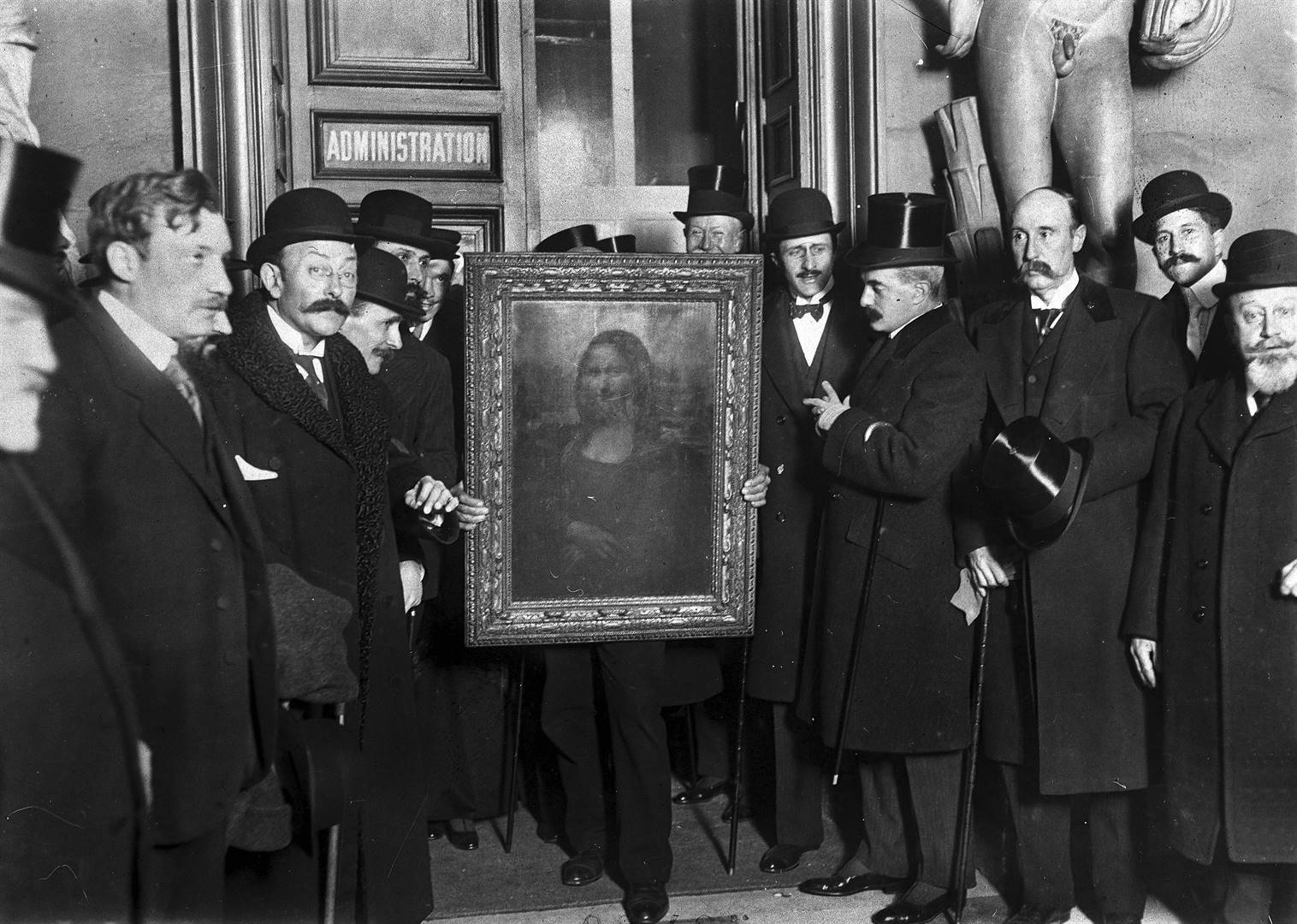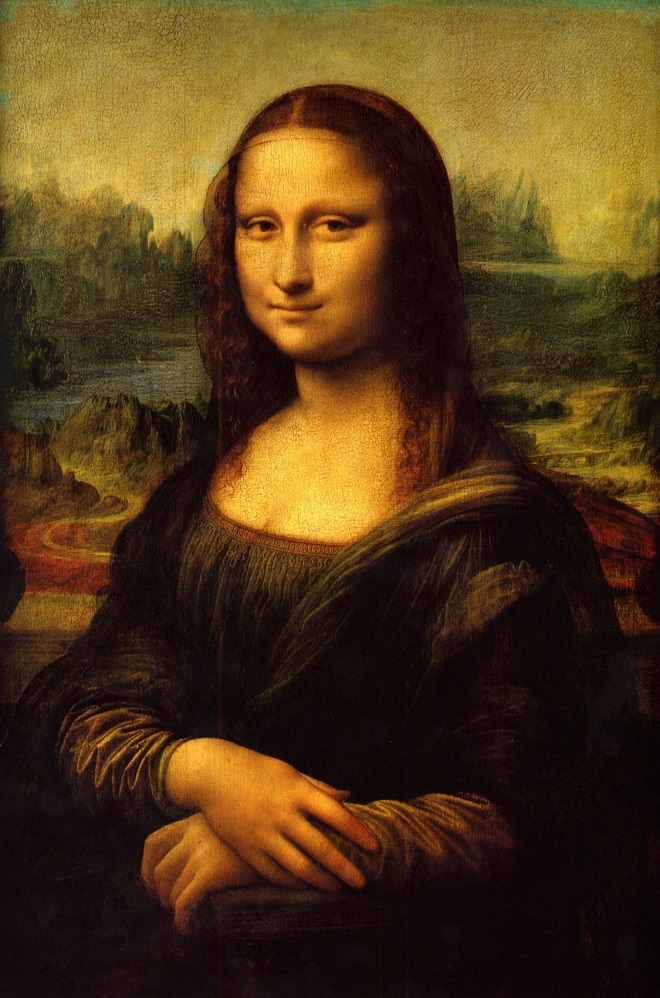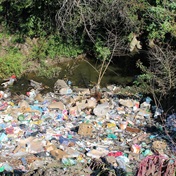
Sunday night was usually a big social night in the early 1900’s in Paris, France. It might not be inconceivable that a few French ladies and gentlemen had a slight hangover from the previous evening and slept in on Monday 21 August 1911. It might also not be inconceivable that no one paid much attention to a handyman, Vincenzo Perugia, walking out of the Louvre on that famous morning with a rolled up painting under his smock.
Mr. Perugia did not have a 'big night' the previous evening. His night consisted of hiding in a closet in the Louvre. On the now-famous morning he simply removed the painting from the wall, got rid of the very protective glass cases he was hired to make for some of the art pieces, and walked out of the building.
Or tried, at least.
When he reached the door, it was locked. In his desperation to get out with the loot, he removed the door handle, but that still did not work. Luckily for him, so the story goes, a plumber walked by, saw the handyman struggling to get out of the building and assisted his colleague in profession.
Vincenzo Perugia stole the Mona Lisa.
With the world’s most famous painting not being in its usual place, everyone was in an uproar. Chaos ensued, and the art world came to a standstill.
Or not.
It was roughly 28 hours before anyone noticed the painting was gone. A still-life artist, looking to paint the gallery, noticed the four bare hooks. No reason to be alarmed, though. Cameras did not work well inside buildings during the 20th century, so the artist figured someone took the Mona Lisa to the roof where paintings were usually photographed, outside. Getting impatient, he convinced a security guard to inquire when the photographers would be done. Only then the realisation ensued that someone had stolen the painting. (The Crimes of Paris: Thomas and Dorothy Hoobler)
Suddenly, in the words of James Zug (writer and historian), the Mona Lisa becomes this incredibly famous painting — literally overnight." Before the heist, "The Mona Lisa wasn't even the most famous painting in its gallery, let alone in the Louvre," Zug says.
All of sudden, photos of the piece were everywhere. Still, the Mona Lisa was not instantly recognisable by most people. In fact the Washington post, when it first published the story, mistakenly ran a picture of the Monna Vanna, a nude charcoal sketch that Da Vinci painted, some believed in preparation for the Mona Lisa.
The now embarrassed French Police had a range of suspects that included America art lover J.P Morgan, Pablo Picasso and even the Kaiser as tensions were escalating between France and Germany before World War One.
Some 28 months later, after hiding the painting in a trunk of his Paris boardinghouse, Mr Perugia tried to finally sell the painting to an art dealer, which didn’t turn out that well for him. He was arrested, pleaded guilty and received a sentence of only eight months.
A few days after his trial, World War One broke out, and suddenly, according to Dorothy Hoobler, "This seemed like a very small story."
The scarcity principle
Robert Cialdini, in his bestseller, Influence, details how the scarcity principle evokes a desire from people to own something, not necessarily, because they need it, but because of the very fact that it is scarce and is perceived to be more valuable than something in abundance.
No "investment advisor", and I use the phrase in quotes on purpose, as I do not regard him as one, know this better than Bernie Madoff. Mr. Madoff was in charge of the world’s largest Ponzi scheme.
Rumour has it that clients begged him to accept and manage their funds. His return was so good and consistent that people in essence said, "Please take my money and manage it for me, please?" and because Bernie did not take just anyone’s money, his service was seen as a scarce commodity reserved only for a privileged few.
Clients of Mr. Madoff included famous people like Kevin Bacon, Kyra Sedgwick and John Malkovich. It was seen as a status symbol to be a client. Perceived as being rare, scarce, and thus attaching a fake value to "owning" something.
Alas, it didn’t work out well for Bernie and his clients, the scheme is estimated to have defrauded clients of close to $65 billion. Some lost so much money that they had to sink to such low levels as starring in a movie called The Darkness.
More, not better
The investment industries devotion to alpha is reminiscent of the research of professors Taffler and Tuckett, who defined 'Phantastic' objects: "attractive objects that stimulate high excitement and almost automatic idealisation and so, a powerful wish to possess." There are investors that only want 'more'. More alpha, better than the competitors, additional, extra.
The industries obsession with alpha has lead so many investors and their clients down the wrong path. We have idealised the wrong goal. The goal should not be alpha, but client objective. What does the client want to achieve?
We as advisors and investment managers need to realise that the only way we achieve success is not measured by alpha, but only if the client achieves their objective. And when the client achieves success or their objective, you will have a client for life.
Bankers (the category of professions investment professionals fall under) are generally rated as one of the least trusted professions in the world, and with all due respect, no wonder. We are chasing something very rare in today’s world, alpha, rather than client achieving their objectives.
Clients so desperately need advisors and investment managers to help them design a concrete investment strategy and more importantly help them to stick to it, rather than picking the right stock to outperform the "rest".
It is truly difficult to put a value to the Mona Lisa. The Culture Trip puts a value of $700 million, William George website at $834 million and one particular Medium.com article at a staggering $2.67 billion. Still a far cry from what Mr. Madoff lost for his investors. The moral of the story, though, is to not value scarcity, or what is seen to be scarce by others, too highly. Rather value what is important to you - read: "your client".
Hannes Viljoen is a Chartered Financial Analyst. Views expressed are his own.




 Publications
Publications
 Partners
Partners












